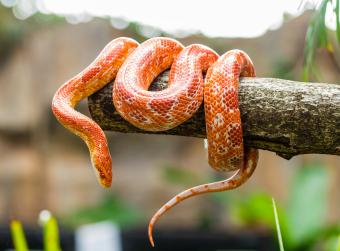
Coral snakes and milk snakes are very different from one another, but they look so similar. Being able to tell them apart is important, because coral snakes are venomous and deadly, while milk snakes and king snakes are harmless mimics. Keep this rhyme in mind as you read this article: Red to yellow, kills a fellow; red to black, friend of Jack. You'll learn why soon enough.
Differences Between Coral Snake and Milk Snakes
As you may be able to tell from the rhyme, learning the difference between coral snakes and milk snakes is important, especially if you live in areas where coral snakes are found. Or, you may be a beginner in the reptile trade world and understanding the difference between safe pets and hot reptile keepers is important.
Additional differences include:
| Difference | Coral Snake | Milk Snake |
| Size | Most coral snakes are usually between 18 and 30 inches, but grow up to 48 inches | 24 to 36 inches long |
| Lifespan | 7 to 10 years in the wild; up to 15 in captivity | 15 years in the wild; up to 20 in captivity |
| Native Habitat | Old world: Asia; New world: Southeastern United States | Throughout the United States, down into Mexico |
| Diet | Smaller snakes, frogs, rodents, and lizards | Eggs of other reptiles, lizards, frogs, rats, mice, smaller snakes |
| Hunting | Paralyze prey with venom | Constriction |
| Coloration | Brighter shades of black, red, and yellow, with the black bands outlined by yellow touching red | Red and yellow separated by black bands |
The Easiest Way to Tell: Coloration
When you see red and yellow bands touching on a snake, that's a very good indication it's a coral snake. Beware, because red and yellow touching means the snake may be deadly. Even with this information, it's difficult to tell these snakes apart. Let's take a deeper look at the differences in their coloration.
Corn snakes are also closely related to kingsnakes and milk snakes, and they come in a variety of color morphs that can be confusing when it comes to identification.
Coral Snake

This Eastern coral snake has vibrant coloring, and the red colors is directly touching the yellow bands. Notice that the black bands and red bands are much wider than the yellow bands.
Milk Snake

This Pueblan milk snake's color pattern is different: it has red bands touching black bands. No yellow touches the red bands. Also, the red bands are wide, where the black and yellow bands are both smaller.
King Snake

King snakes also mimic the look of coral snakes, but you can see their coloration is quite a bit different. Their red bands never touch their yellow bands. They also come in a wide variety of colorations, and often the yellow bands are replaced with white.
Why Milk and King Snakes Adopted this Coloration
Since the coral snake is venomous and the milk snake is not, it makes sense for the milk snake to evolve to this color pattern. The resulting effect is that predators are more likely to be wary of the milk snake. It's a defense mechanism.
If you think of other animals in nature, such as the very poisonous dart frog, a lot of dangerous animals are brightly colored to warn predators not to eat them ... or else!
Both milk and king snakes eat other snakes, which means you need to keep these reptiles alone in their enclosures. They will even eat other members of their species.
4 Other Differences
If you look closely, you'll see other differences between milk snakes and coral snakes.
- Size: Coral snakes are typically longer and thinner than milk snakes, though this isn't always the case.
- Habitat: Coral snakes prefer to live in forested areas, hiding under rocks and leaves, or desert. Milk snakes are more widespread.
- Pattern: Coral snakes almost always have even color bands, where milk snakes can have blotches, thin stripes, or broken bands of color.
- Face: Coral snakes have small heads that are completely black. Milk snakes have color on their faces and heads.
Similarities in Milk and King Snake Husbandry
The milk snake and king snake have a lot of similarities in regard to how they're cared for:
- Activity: Coral snakes and milk snakes are nocturnal and spend most of the day hidden
- Diet: They can both be fed thawed mice in captivity
- Temperature: Both of these snakes prefer a tropical-type environment
- Substrate: Since both snake types prefer to hide during the day, their substrate should allow them to do so
- Terrarium additions: The coral snake and milk snake both prefer to hide, so they should have plenty of places to hide if desired.
Although coral snakes are beautiful, they are an incredibly dangerous species to keep as a pet. There is an antidote for their venom, but side effects could occur immediately following a bite and it could be fatal.
Be Cautious
Coral snakes are very dangerous, and should never be handled. People who keep venomous snakes have "hot rooms" where they follow strict protocols to keep safe. Milk and king snakes, on the other hand, are not venomous and make excellent pets. They're easy to keep and handle, and are wonderful beginner snakes if you're just starting out in the world of reptiles.







